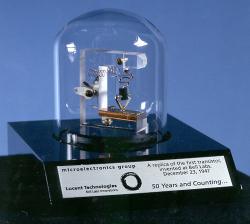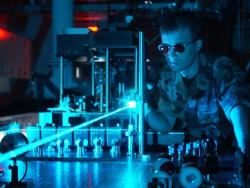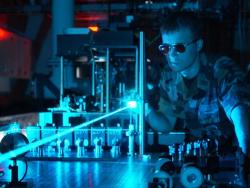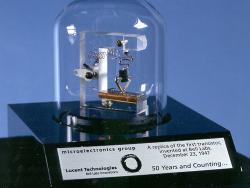Bell Labs

On the greeting-card racks this past Christmas could be seen a minor technological miracle—a Christmas card that upon opening showed a small yellow light that glowed while the card played a tinny but recognizable version of “Jingle Bells.” The yellow light was the latest addition to a novelty that made its first appearance a couple of years ago—the electronic greeting card.
HALF A CENTURY AGO AMERICAN PHYSICISTS created two of our era’s most important inventions. At Los Alamos, New Mexico, the Manhattan Project built the atom bomb. At Bell Telephone Laboratories a much smaller group of scientists made the transistor. The director of the latter project, Mervin Kelly, parlayed his achievement by building Bell Labs into the nation’s greatest industrial research center. Until its offspring, Silicon Valley, came to the fore during the 1960s, the institution Kelly built stood alone at the top.
Bell Labs’ Greatness
I AM NOW A VISITING PROFESSOR OF music emeritus at Stanford University. I looked back many years with keen nostalgia when I read the fine piece “What Made Bell Labs Great,” by T. A. Heppenheimer, in your Summer 1996 issue. I encountered again the Labs’ “broad (but not unlimited) domain … ripe for innovation.” I admired again one of my heroes, M. J. Kelly, and recalled various other characters named or discussed, including myself.

As ideas developed, they abandoned infrared radiation to instead concentrate upon visible light. The concept originally was called an "optical maser". In 1958, Bell Labs filed a patent application for their proposed optical maser; and Schawlow and Townes submitted a manuscript of their theoretical calculations to the Physical Review, published that year in Volume 112, Issue No. 6.
Simultaneously, at Columbia University, graduate student Gordon Gould was working on a doctoral thesis about the energy levels of excited thallium.
Summer 1986 | Volume 2, Issue 1
On the greeting-card racks this past Christmas could be seen a minor technological miracle—a Christmas card that upon opening showed a small yellow light that glowed while the card played a tinny but recognizable version of “Jingle Bells.” The yellow light was the latest addition to a novelty that…
Summer 1996 | Volume 12, Issue 1
HALF A CENTURY AGO AMERICAN PHYSICISTS created two of our era’s most important inventions. At Los Alamos, New Mexico, the Manhattan Project built the atom bomb. At Bell Telephone Laboratories a much smaller group of scientists made the transistor. The director of the latter project, Mervin Kelly…
By:
Fall 1996 | Volume 12, Issue 2
Bell Labs’ Greatness
I AM NOW A VISITING PROFESSOR OF music emeritus at Stanford University. I looked back many years with keen nostalgia when I read the fine piece “What Made Bell Labs Great,” by T. A. Heppenheimer, in your Summer 1996 issue. I encountered again the Labs’ “broad (but not…
Innovations

As ideas developed, they abandoned infrared radiation to instead concentrate upon visible light. The concept originally was called an "optical maser". In 1958, Bell Labs filed a patent application for their proposed optical maser; and Schawlow and Townes submitted a manuscript of their theoretical… Read More



